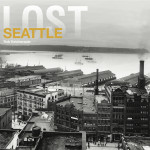Belltown, coolest and most expensive neighborhood in Seattle, isn't spared freeway woes.
This is part of the special feature Freeway Box, showcasing my old life next to freeway viaducts.
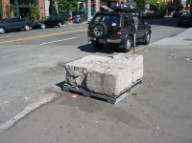
Belltown has really turned into a great place to walk. There's all sorts of cafes and boutiques and shops to drop into. They've put in all sorts of amenities like benches and sidewalk cafes and signs and artwork. There's a whole series of brutalist concrete art that can be used for benches or skateboard ramps, it's so mundane that you might not notice it.
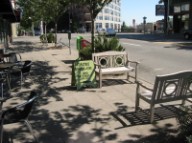
One great feature of Belltown is how thick it's gotten. There are fewer and fewer blank parking lots, fewer empty storefronts or unused street level spaces. In this scene, look at how attractive it is to pedestrians. The only confusing thing is the hole in the streetscape on the other side. Why haven't they developed there?
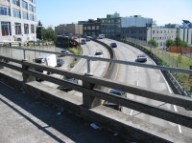
Wandering across the street to check it out reveals the relatively, in terms of freeways downtown, petite form of SR 99, aka the Alaskan Way Viaduct, diving into the Battery Street Tunnel.
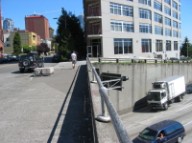
On this day there was a delivery truck debating when the right moment would be to gamble and enter traffic from a dead stop on the short entrance with no visibility.
Imagine how much money is lost to Seattle because state highway planners couldn't figure out how to bring it in a little lower and allow a building to be placed here. The condos in the neighboring property are worth a combined value of $25,244,300 (2004). Think about all of that property tax, and all of the parks and schools and medic 1 units it funds, in addition to the police and roads money out of the general fund. The apartment next to it is taxed at more than $3,000,000 worth of value. A condo building across the street has a total value of $11,356,000. Who knows how much business tax the lower floor commercial residents pay, or how many jobs they supply.
Rather than receiving money from this space, the city, county, and state are all footing the bill for maintenance and eventual replacement. The highway provides unquestionable mobility, but design decisions squander precious developable land and the resulting prized property and B&O tax.
Why are people so confused about why our tax system is ballooning? In early streetcar-based developments in Seattle, the real estate developer paid initial transportation construction costs as part of the cost of the homes. Flimsy structures were left to pay for maintenance, and eventually the streetcar lines were abandoned. The highway wave was built *in advance* of development. The public paid for the transportation, and the developers cashed in on previously worthless rural properties. The rich get richer, and the taxed get taxeder.
